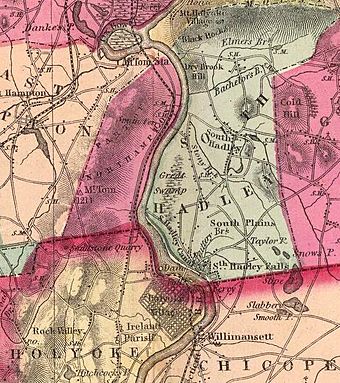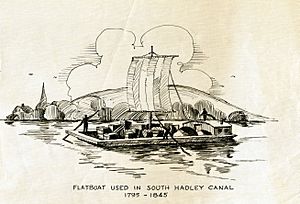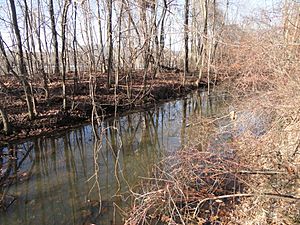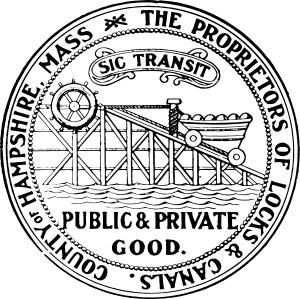South Hadley Canal facts for kids
Quick facts for kids |
|
|
South Hadley Canal Historic District
|
|

Map of the canal
|
|
| Lua error in Module:Location_map at line 420: attempt to index field 'wikibase' (a nil value). | |
| Nearest city | South Hadley, Massachusetts |
|---|---|
| NRHP reference No. | 92000077 |
| Added to NRHP | March 11, 1992 |
The South Hadley Canal was a special waterway built next to the Connecticut River in South Hadley, Massachusetts. It was the very first canal in the United States that boats could travel on! It started working in 1795. Today, this historic area is known as the South Hadley Canal Historic District and is listed on the National Register of Historic Places.
Contents
Why Was the South Hadley Canal Built?
In 1792, people in western Massachusetts had a big problem. The Connecticut River had a huge waterfall called the Great Falls at South Hadley. This waterfall was about 53 feet (16 meters) high. It completely stopped boats from traveling further up or down the river.
Because of the falls, all goods had to be taken off boats. Then, they were carried by land for about 2.5 miles (4 kilometers) around the waterfall. This made river travel very expensive. For example, moving wheat from Northampton, Massachusetts to Windsor, Connecticut cost more than twice as much as shipping it by sea from Hartford to Boston!
Getting the Canal Started
To solve this problem, important people decided to build a canal. This canal would let boats go around the falls. John Hancock, who was the Governor of Massachusetts at the time, signed the official paper to create a company. This company was called the "Proprietors of the Locks and Canals on the Connecticut River." They had a special motto on their company seal: "SIC TRANSIT - Public & Private Good," which means "Thus passes - Public & Private Good."
Building and Using the Canal
Money for the canal came from both local people and from other countries. Four companies from the Netherlands owned a little more than half of the company's shares. About 240 local workers helped build the canal.
In April 1795, the South Hadley Canal opened for boats carrying goods. Another nearby canal, the Turners Falls Canal, opened a few years later. In its first year, the South Hadley Canal earned $3,109. They charged 75 cents for every ton of goods. By 1816, the money earned from tolls had grown to over $16,000!
In 1826, the Barnet, which was the first steamboat on the Connecticut River, traveled through the South Hadley Canal. It was on its way to Vermont. However, by 1843, new railroads started to take away business from the canal. The canal eventually closed in 1862 because it was no longer making enough money.
How Boats Moved Through the Canal
The South Hadley Canal used a very unusual method to move boats over the falls. Instead of traditional canal locks, it had an "inclined plane." This was the first time an inclined plane was used on an American canal. It was a bit like a ramp for boats!
The Inclined Plane
The inclined plane was used to move flatboats, which were about 20 feet (6 meters) wide and 60 feet (18 meters) long. Here's how it worked:
- A boat would first be guided into a special cart.
- This cart would then be pulled up or down a ramp.
- The ramp was made of strong stone and wood planks. It was about 275 feet (84 meters) long and 30 feet (9 meters) wide.
- Two large waterwheels, each 16 feet (5 meters) across, provided the power. One waterwheel was on each side of the ramp.
- Chains connected the waterwheels to the cart.
- The cart had different-sized wheels to keep the boat level as it moved.
- Moving a boat up or down the inclined plane took about 15 minutes.
Replacing the Inclined Plane
After about 10 years of use, in 1805, the inclined plane was replaced. The canal needed to be made deeper. So, instead of the ramp, a series of five canal locks were built. Locks are like water elevators that raise or lower boats from one water level to another.
The Canal Today
Today, you can visit The Bicentennial Canal Park. It's a historic spot that helps remember the canal. From an overlook deck, you can see beautiful views of the Mount Tom Range and the Connecticut River.
The Holyoke Gas & Electric Department also takes care of Texon Park, Lower Riverside Park, and Gatehouse Park near the Holyoke dam. If you visit Lower Riverside Park, you can look out over the place where the inclined plane and lock system used to be. You can still see parts of them today!




